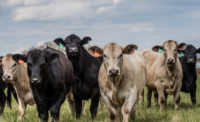State of the Industry
State of the Meat and Poultry Industry 2017: Animal welfare
Keep driving to improve animal care, handling

An improvement mode continues for humane handling and stunning in beef and pork plants in North America. The framework of the North American Meat Institute’s Animal Care and Handling Guide has been tightly woven into the cultural fabric of most quality-assurance departments.
The focus has largely turned to refinement of stunning and handling methods and greater focus on understanding customer needs. Some of the adjustments that have been made are small, while others are centered on larger issues that weren’t receiving attention.
Captive bolt stunning for large bulls
In the beef industry, the standard procedure for captive bolt stunning bulls includes the typical “double-knock” or “security knock” — the application of the first stun followed quickly by a second. The application of two or more captive bolt stuns will not result in regulatory action unless the first stun was not effective or an animal is allowed to return to consciousness at any time after the first stun occurs. During animal welfare audits, auditors are required to check for signs of return to consciousness after the first stun and before the second stun is applied.
Some beef processors have faced regulatory action in recent years, the result of cases in which bulls were insufficiently stunned on the first attempt or displayed signs of return to consciousness at or before the bleed rail. The effective solution to the challenge of stunning large bulls has been the application of a double-knock for at least the past decade. As long as the animal loses consciousness instantly and never returns to consciousness, this procedure is legal and acceptable.
More recently, some processors and equipment manufacturers have begun to modify pneumatic captive bolt stunning equipment to provide an impact that can consistently stun large bulls with a single, well-placed application. At this time, the modified device is not commercially available, but product development is well underway.
Next steps for controlled-atmosphere stunning
We need to be sure of what happens in controlled-atmosphere stunning systems. In a recent visit to a pork slaughter plant, the quality-assurance director touted the advances her facility had made in humane handling and stunning with their conversion from electrical to controlled-atmosphere stunning.
If you haven’t observed the transition before, the improvement in ease of movement when the switch is made from moving pigs into a single-file chute to feed a V-restrainer to the movement of groups through wide alleys is an incredible contrast. The pigs move more quietly and with greater ease in groups. The place where we need to focus next is the reaction of pigs to the gas in the stunning system. During the installation process, be sure to at least install the necessary network and power utilities to install cameras in that space. The best time to install the necessary conduit and wiring is while the controlled-atmosphere system is being installed.
You need to know how animals are responding as the gas profile changes so adjustments can be made if needed. The behavior of the animals in the system is the best indicator we have of their welfare.
Continued development of systematic approaches and reaching to the farm level
The majority of larger slaughter facilities have had humane-handling programs in place for five years or more. Mid-size and small plants are rapidly developing their own programs either by choice or as a result of customer or regulatory request.
Installation of systematic approaches to animal welfare is different in smaller plants than larger plants in part due to scale — fewer people and fewer animals. The development and adoption of a systematic approach is not unlike the installation of HACCP programs in the late 1990s and early 2000s. One of the keys to successful implementation is to make the initial program simple and as easy to use as possible. This is the foundation that future iterations of the systematic approach will rest on.
Many companies with well-developed systematic approaches to animal welfare have been working to understand the opportunities for improvement that exist upstream in their supply chains. This has involved the development of farm-level animal-welfare auditing and expansion of remote video-auditing systems to the farm level. The trend toward increased interest in how animals are raised, handled and cared for at the farm will likely continue for the foreseeable future.
Animal care and handling requests by customers
It is reasonable to expect companies that purchase animal-based raw materials or finished product to continue to express interest in how animals are raised and slaughtered, as it is being requested by the end users of their products, the consumers. At first, it may seem intrusive or demanding, but more often than not, they are asking because a consumer asked and they were not in a position to answer.
As your customers work to understand their role in farm animal welfare assurance and improvement, meaningful engagement will get you further than resistance. Many companies already have developed or are developing internal advisory boards. Allowing seats at the table for suppliers gives them an opportunity to explain what is possible and what they will need to meet customer requests. If your customer shares that they are developing an advisory board, ask for a seat at the table. Many customers would likely appreciate the willingness to engage.
Embrace the unknown
When it comes to raising and slaughtering animals for food, you can’t afford to fear what you don’t know. Although the unknown is anxiety-provoking for most, there is also a false sense of comfort in avoiding it.
When it comes to humane handling and stunning, we need to continue to look where we are afraid to look and roll up our sleeves to find the best fix we can. This isn’t an option; it’s the expectation. NP
State of the Industry 2017 Segments
Looking for a reprint of this article?
From high-res PDFs to custom plaques, order your copy today!






